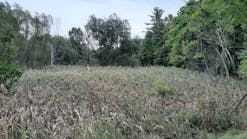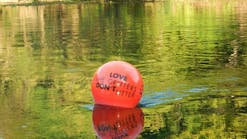Controlling sediment concerns more than just state and federal regulators. In a recent Sarasota, FL, project, clean water was important to the resident fish as well as the developers of a world-class competitive rowing facility.
“The project was a fishery relocation, draining a 40-acre lake. Cattleman Road was being extended, right through the lake we drained. We had to make another lake,” explains Shawn Riley of Vero Beach, FL’s StormWater Environmental (formerly known as Native Lands). “As the lake tied in with Benderson Reservoir, a rowing facility, the water needed to be as clean and clear as possible. Along with extending the road, the reservoir needed to be 2,000 meters longer, so world-class events could be held there. Cattleman Road includes a bridge over the lake; rowers now can travel under the bridge and turn around. In the past, they’d cross the finish line and be on shore.”
Due to the complexity of the project, construction disturbed 90% of the soil around the dewatered lake, making any significant rain event more challenging to the operations by increasing the water’s turbidity level. Turbidity levels were as high as 172 to 846 nephelometric turbidity units (NTUs). Florida regulations required effluent levels below 29 NTUs over background. As the background was 3 NTUs, the discharge could not exceed 32 NTUs. Daily operations consisted of adding fill dirt to the lake perimeter, slowly reducing the lake’s footprint, until it was entirely filled in. As some “filling in” was accomplished by adding rich organic loam, which is high in tannic acid, this made the turbidity’s settling even more challenging.
After flowing through a lined channel with rock check dams, water was refiltered and discharged to the reservoir.
“We initially looked at the project, and we worked with HaloKlear [now HaloSource],” Riley says. “We told them what we wanted to do, asked what would work, and their engineers worked with us on the plan. We decided to work with them because the environment needed zero toxicity. The reservoir had a background NTU level under 5-very clean and clear. However, the old lake was a borrow pond created when construction crews had taken the soil to build I-75. The area’s soil is mostly sandy, with a bit of clay, so the challenges were evident.
“To give you an idea of the soil’s clay content,” he says, “on Florida’s east coast you have to put up a form when installing a swimming pool, because the sandy soil won’t hold a shape. On Florida’s west coast, such as Sarasota, where we were working, the form isn’t needed, because the clay soil holds the shape.”
Riley’s firm worked on the project during fall 2011. “Our part was draining the borrow pond, relocating the fish there, and installing the piping to move the reservoirs,” he says. “Working with the Florida Wildlife Commission, we used a seine net to catch the fish. While we had the chance, we took out the non-native species, mostly tilapia, and donated them to nonprofit shelters. Our haul made quite a fish fry for the homeless.”
To lower turbidity levels, a simple manifold kit housing HaloKlear dual biopolymer socks was built for deployment. To aid in the settling process and reduce costs in the sediment bags, a 3,000-gallon weir tank was brought in and retrofitted to accommodate a 600-gallon-per-minute (GPM) flow rate. Because of fluctuating NTU levels, samples were taken every half-hour to satisfy regulatory monitoring logs. Residual tests were taken every three hours. Riley’s firm used the HaloKlear Biopolymer Test Kit, which detects the presence of free residual biopolymer so it can be removed before it can leave the job site.
As the borrow pond had a high organic content, and the weir tank could not settle all material, sediment bags were deployed to capture any excess material. Sediment bags also aid in filtering suspended
fine particles in the water column. After approximately 15 hours of pumping, NTU readings averaged between 2.85 and 12.0. Sediment bags and dual biopolymer socks were changed after 15 hours of use, treating approximately 540,000 gallons.
After successful testing of a semi-passive treatment model leading into a weir tank, StormWater Environmental, along with Prince Contracting, made changes to the treatment train. The weir tank and the sediment bags were removed, and a 60-foot-long, 8-foot-wide channel was constructed, which included rock check dams and filtration media (excelsior blankets). “We installed the rock check dams to slow the water down in its path from lake to reservoir. As the manifold flow rates ranged from 900 to 1,100 gpm, we wanted to slow that influent into the reservoir. This channel was fed by a manifold system built with HaloKlear’s SockMaster Manifold Kit; the DBP-2100 sock was used in the first chamber, and GelFloc was used in the second chamber of the manifold system. This flocculated the sediment and pulled it down to the bottom.”
This project was the first time Riley had used HaloKlear products. “We couldn’t afford to have a fish kill or a plume of dirty water going into the reservoir. HaloKlear’s products made it possible for us to combine the two waterways, making the reservoir as clean as possible. Sarasota County was recently recognized for its environmental projects, and for how “˜green’ the county is.” Along with creating a clean, world-class rowing facility, the Cattleman Road project could also create economic growth; it’s estimated that the rowing facility could generate about $160 million a year in economic activity.
Along with rowing and fishing, will that activity include recreational swimming? “Oh, no,” Riley laughs. “Swimming isn’t allowed there. There are 14-foot gators in that lake!”
A Cliffhanger
It’s been said that good fences make good neighbors. In some neighborhoods, a large helping of erosion control BMPs is what’s needed to keep a block from falling apart-sometimes, literally.
“We were trying to help one of our maintenance clients with an erosion issue. The property is an apartment community located near the coast,” reports Mick Farris, operations manager for San Diego, CA’s LandGraphics. “The adjacent property is a sandstone cliff, which erodes during rain events and washes sand and silt onto our client’s property. In this instance, there’s a big chute that collects water from the cliff face and dumps it at the rear of our client’s property. In California, the regulations prohibit silt, debris, or other pollutants from entering storm drains and waterways, and violators can receive large fines. In the past, we have installed sandbags, which deteriorated within a couple of years-leaving sand and deteriorated bags. We then had to remove the sand buildup by trucking it out to soil depositories, which ran into considerable cost. In recent years, the erosion has been getting worse so we decided to look for a better solution.”
Manifold system built with the SockMaster Manifold Kit
For this project, Farris relied on his supplier, Summit Erosion Control. Summit suggested using compost socks from Grafton, OH’s Filtrexx International LLC. “We’ve used Filtrexx FilterSoxx primarily for erosion control, at the edge of slopes and in drainage swales. Last year, we put out a series of socks on this property, which did a pretty good job, but heavy rains and the volume of sand overwhelmed them. So we tried a silt dam this year, built from Filtrexx Channel Soxx. We used 12-inch-diameter socks, five rows thick at the bottom, five rows high, stacked like a pyramid.”
Unlike the ancient Egyptians, Farris assembled his pyramid the easy way-building the “blocks” in place. “As big and heavy as these socks would become, it would’ve been too labor intensive to move them in prefilled. So, once we determined the layout for the Channel Soxx, Summit Erosion Control’s crew filled them onsite with a blower truck. This didn’t take long; Summit was finished with the whole project in a day and a half. Once the dam was in place, Summit blew on a compost blanket with native seed in it so we could vegetate the dam and create a natural barrier for the sand that would also filter the large volume of water coming off the cliffs.”
Channel Soxx saved time and money as well as stopping the sand. “We don’t have to worry about cleaning these up once they’re in, and compared to traditional sandbagging, these socks are much less labor intensive. Channel Soxx are more affordable. And, in this case, you have the added bonus-the Channel Soxx Summit uses last much longer than sand bags and in place, and the compost is a good growing medium for revegetation.”
This was the first time LandGraphics had used Channel Soxx, and the experience convinced Farris that the product could open up new business opportunities for his firm. “For us, what we can do with
Channel Soxx creates another service we can offer our clients, to meet a variety of needs. We’ve also worked on construction sites where the land might lie dormant for a couple of years due to the economy. Channel Soxx would be a great fit on many of those projects.”
Socks Onsite and Door-to-Door
Summit Erosion Control uses Filtrexx products on many construction sites. “A prominent San Diego home-builder has been using Filtrexx products for the past year,” says Craig Kolodge, Ph.D., director of business development for the Poway, CA-based company, which is that area’s Filtrexx certified manufacturer. “The Filtrexx SiltSoxx are installed both when the subdivision’s roads are in, but houses have not yet been built, and during active construction.”
In one such development, approximately 160 acres of open land were graded, with roads and pads in place. “This is an extremely environmentally sensitive area, with streams and very mobile silty soil. The area had to be stabilized; any runoff could threaten the quality of the receiving waters nearby. The developer invested a lot of money to meet California’s permit regulations; the company wanted BMPs with good research behind their performance, and they wanted something that would last. Compost addresses NDPES [National Pollutant Discharge Elimination System] Phase II requirements, filtering sediment-laden water through compost and maintaining quality of receiving bodies of water. The client standardized on Filtrexx compost socks for sediment control and as a slope interruption device.”
Filtrexx launched a new national pallet program in 2011. “Compost socks can be manufactured two ways,” Kolodge explains. “They can be made onsite, filled in place with a blower truck. A filled 8-inch-diameter sock weighs approximately 13 pounds per linear foot; because it’s heavy, it stays in place and doesn’t require trenching. Sometimes, though, palletized socks are more portable, and allow the end-user to move socks where they need them, as well as stockpile extra if needed. When we couldn’t get a blower truck to their site, we’d palletize compost socks at our production yard in Chula Vista. We produced long coils of 8-inch-diameter socks, up to 150 feet long, which our client placed on level ground by using a skid-steer.
“This client likes the 8-inch size sock, but we can palletize up to 18-inch socks, although those are really heavy-approximately 67 pounds per foot,” he notes. “The client used the smaller 8-inch blown-in socks as slope interruption devices and check dams. As this particular site may sit and not be developed for the next five years, they wanted the products to last-something they wouldn’t have to keep replacing, or that needed continual maintenance, such as wattles or silt fence. Other erosion control methods might have been cheaper up front, but in the long run, Filtrexx was less costly. Some firms have to learn that lesson the hard way,” he chuckles.
Kolodge did whatever made the job easier for his client. “As it was a challenge to take the socks up slopes, blower-truck installation solved that problem. We also blew and lined socks on pads so the homebuilder’s crews could cut them to size and move them around where they need them. Some early rains earlier in fall 2011 really tested the performance of newly installed compost socks, but our client’s consulting engineer was pleased-there were no failures.
“The client had also put a tremendous amount of hydromulch with seed on the slopes for erosion control. In some cases, they were not careful and covered the Filtrexx Soxx with hydromulch. If you do that, it seals the mesh, and the sock then acts like a straw wattle-the hydromulch stops its filtering capacity. However, if mulch gets onto the socks, you can simply take a broom, or something that won’t damage the sock, and remove the hydromulch, which easily restores the sock’s filtering capabilities. But if you don’t remove the mulch, the socks will still be as effective as a straw wattle, yet last three to five times longer under normal conditions.”
The pallet program allows Kolodge’s firm to offer products to a variety of clients. “When a storm comes up, people call and say they want BMPs right now. So we palletize them and have our distributor ship them to a site. Because Filtrexx SiltSoxx are so sturdy, you can stack them, to get more height when needed, so your site can handle higher flow rates of stormwater.”
Kolodge explains, “The sock is a containment system for moving composted mulch where you need it and keeping it in place. But not just any compost might work as intended. People should be trained
how to properly install socks, even if they have good socks and medium; you need to know the basics to get the best results. Filtrexx provides SWPPP [stormwater pollution prevention plan] cut sheets and an extensive online design manual on the proper use and installation of compost socks, at no charge. The last thing we want is someone not knowing what they’re doing; that won’t serve their purpose, and it would make us look bad. Our goal is to make sure people using the product know what they’re doing, so they install them correctly, with the right filter medium. In San Diego, we exclusively use a municipal yardwaste mix that meets Filtrexx’s filter media specifications.”
Kolodge explains the standards demanded by Filtrexx and Summit Erosion Control. “We also use the Standard Testing Assurance system developed by the US Composting Council to assure a high-quality compost with no pathogens or detrimental attributes associated with it. Many sizes of socks are available, but only two types of media are used: one for filtering, and one for supporting vegetative growth. Those that have growing medium can be used to establish permanent vegetation and may qualify contractors for additional LEED credits on their projects. Of course, established vegetation is the best filtering device nature can provide; it not only filters contaminants from stormwater but also stabilizes the soil, preventing erosion from occurring.”
This silt trap protected an inlet at an apartment complex from being overwhelmed with sediment.
The Filtrexx specifications were established during 10 years of testing. “They found these high standards increase the likelihood that the compost socks will perform the way tests have shown,” Kolodge says. “The USEPA is particularly high on compost-based BMPs-in addition to controlling erosion, using compost is a conservation of natural resources. Many cities have wondered, “˜What do we do with all the yardwaste?’ In yardwaste collection systems, composting speeds up the process of decomposition-less space, less waste-and then compost socks offer them a use for that “˜product.'”
Summit Erosion Control buys its compost from the city of San Diego. “They process and screen it, have it tested, and so on. It’s a great partnership. Plus, they’re planning to use the socks we manufacture in their landfill, to control stormwater pollutants. It takes an astute organization to manage its yardwaste reuse. Yard trimmings are no longer seen as a waste product; we’re adding value through composting, and increasing quality of life and the environment.”
He adds, “Compost socks have become the standard to keep contaminants from entering streams. It’s been said, “˜Nobody does it better than nature.’ Mimic its processes, and you’ll be fine,” Kolodge concludes. “Compost BMPs accelerate what nature would do if given enough time and the right conditions.”












